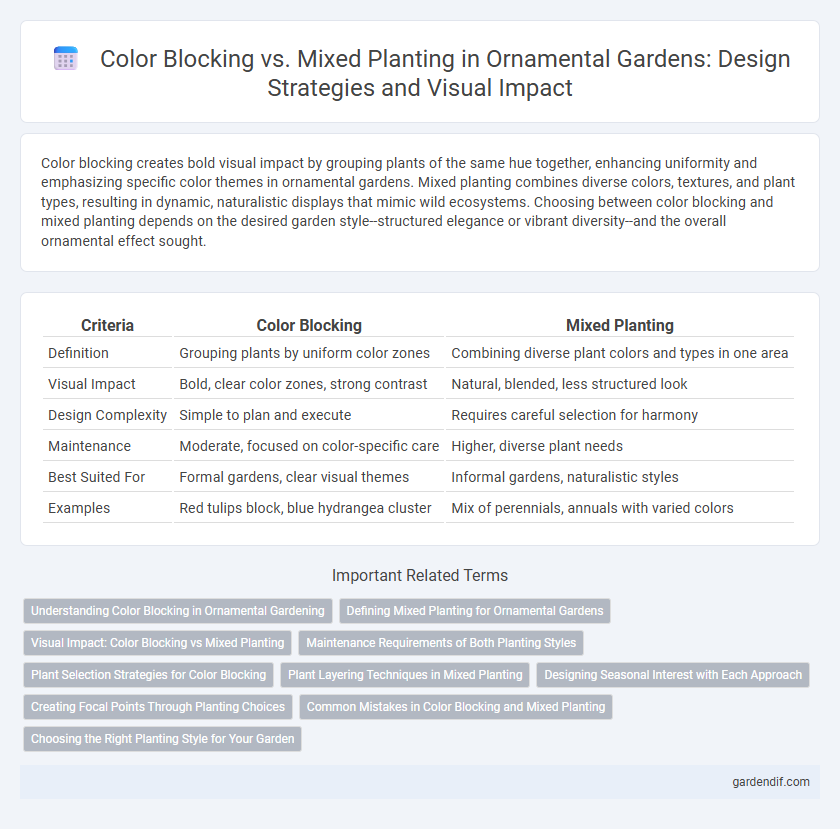
Color Blocking vs Mixed Planting Illustration
Color blocking creates bold visual impact by grouping plants of the same hue together, enhancing uniformity and emphasizing specific color themes in ornamental gardens. Mixed planting combines diverse colors, textures, and plant types, resulting in dynamic, naturalistic displays that mimic wild ecosystems. Choosing between color blocking and mixed planting depends on the desired garden style--structured elegance or vibrant diversity--and the overall ornamental effect sought.
Table of Comparison
| Criteria | Color Blocking | Mixed Planting |
|---|---|---|
| Definition | Grouping plants by uniform color zones | Combining diverse plant colors and types in one area |
| Visual Impact | Bold, clear color zones, strong contrast | Natural, blended, less structured look |
| Design Complexity | Simple to plan and execute | Requires careful selection for harmony |
| Maintenance | Moderate, focused on color-specific care | Higher, diverse plant needs |
| Best Suited For | Formal gardens, clear visual themes | Informal gardens, naturalistic styles |
| Examples | Red tulips block, blue hydrangea cluster | Mix of perennials, annuals with varied colors |
Understanding Color Blocking in Ornamental Gardening
Color blocking in ornamental gardening involves grouping plants of a single color or shades within a limited palette to create bold visual impact and structured design. This technique emphasizes contrast and cohesion by concentrating color intensity in defined areas, enhancing garden focal points and pathways. Understanding color blocking enables gardeners to manipulate plant selection and layout strategically for maximum aesthetic appeal and spatial harmony.
Defining Mixed Planting for Ornamental Gardens
Mixed planting in ornamental gardens involves combining diverse plant species with varying textures, heights, and colors to create a dynamic, naturalistic landscape. This approach emphasizes biodiversity and visual interest by blending perennials, shrubs, and groundcovers in harmonious arrangements that mimic ecological communities. Unlike color blocking, which groups uniform hues together, mixed planting fosters year-round appeal through contrasting foliage and seasonal blooms.
Visual Impact: Color Blocking vs Mixed Planting
Color blocking in ornamental gardening creates bold, defined areas of solid colors, generating a striking visual impact through contrast and uniformity. Mixed planting integrates diverse hues and textures within the same space, offering a dynamic and naturalistic appearance that engages the eye with varied focal points. Emphasizing high-contrast palettes in color blocking maximizes vibrancy, while strategic color combinations in mixed planting enhance depth and visual complexity.
Maintenance Requirements of Both Planting Styles
Color blocking in ornamental gardening demands consistent maintenance with regular pruning and weeding to preserve clear, defined color zones and prevent plant overgrowth. Mixed planting requires more adaptive care, as diverse species have varying water, sunlight, and soil needs, necessitating attentive management to ensure each plant thrives. Both styles benefit from seasonally adjusted fertilization, but color blocking typically involves more frequent grooming to maintain visual impact.
Plant Selection Strategies for Color Blocking
Color blocking in ornamental gardening emphasizes selecting plants with bold, contrasting hues and uniform textures to create distinct visual sections that enhance garden structure. Choosing species with consistent bloom times and complementary foliage colors ensures sustained vibrancy throughout growing seasons. Strategic plant selection involves focusing on cultivars known for intense pigmentation and adaptability to the garden's microclimate to maximize the color impact and plant health.
Plant Layering Techniques in Mixed Planting
Plant layering techniques in mixed planting enhance ornamental appeal by combining diverse plant heights, textures, and colors to create depth and visual interest. Unlike color blocking, which relies on solid, contrasting color zones, layering uses sequential plant arrangements to form natural transitions and rich, dynamic compositions. This method maximizes garden biodiversity and promotes a harmonious ecosystem while offering year-round aesthetic variety.
Designing Seasonal Interest with Each Approach
Color blocking creates strong visual impact by grouping plants of the same hue, enhancing seasonal interest through bold, uniform swathes that highlight changing foliage and blooms. Mixed planting blends diverse colors, textures, and heights to produce dynamic, layered compositions, ensuring continuous seasonal appeal with varied flower cycles and contrasting elements. Both techniques leverage plant selection to maintain vibrant ornamental displays throughout spring, summer, and fall seasons.
Creating Focal Points Through Planting Choices
Color blocking in ornamental gardening uses bold, solid sections of single-hue plants to create strong visual focal points that draw the eye immediately. Mixed planting combines diverse species and colors for a dynamic, textured appearance, emphasizing natural harmony while subtly guiding attention. Strategic use of contrasting colors and varied plant forms in both methods enhances depth and interest in garden design.
Common Mistakes in Color Blocking and Mixed Planting
Common mistakes in color blocking include overusing overly saturated colors that clash and failing to consider the scale and spacing between blocks, resulting in a disjointed appearance. In mixed planting, errors often involve neglecting plant compatibility, such as combining species with vastly different water or light requirements, leading to poor growth and imbalance. Both approaches benefit from strategic planning that respects color harmony and plant health to enhance ornamental appeal.
Choosing the Right Planting Style for Your Garden
Color blocking creates bold, visually striking garden sections using uniform groups of single-color plants, enhancing structure and clarity. Mixed planting combines diverse species and colors, promoting biodiversity and a natural, dynamic aesthetic that supports local wildlife. Selecting the right style depends on garden size, maintenance capacity, and desired visual impact, with color blocking suiting formal designs and mixed planting favoring informal, ecological approaches.
Color Blocking vs Mixed Planting Infographic

 gardendif.com
gardendif.com